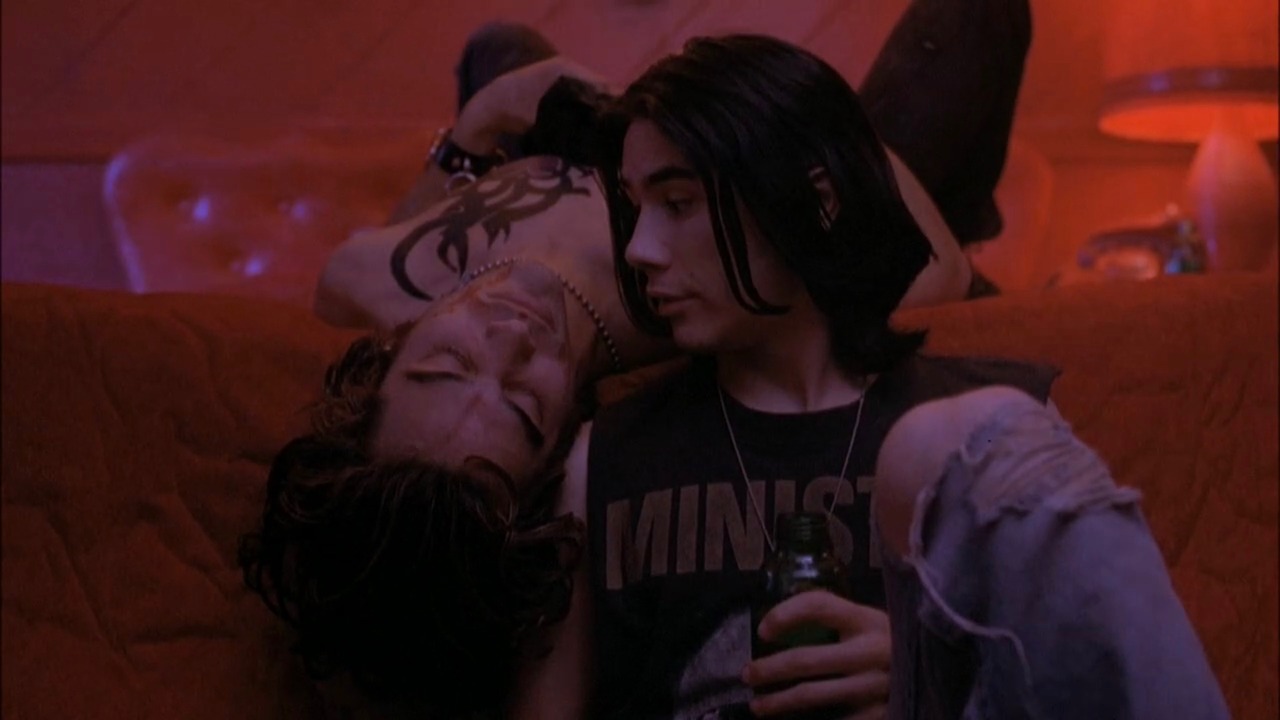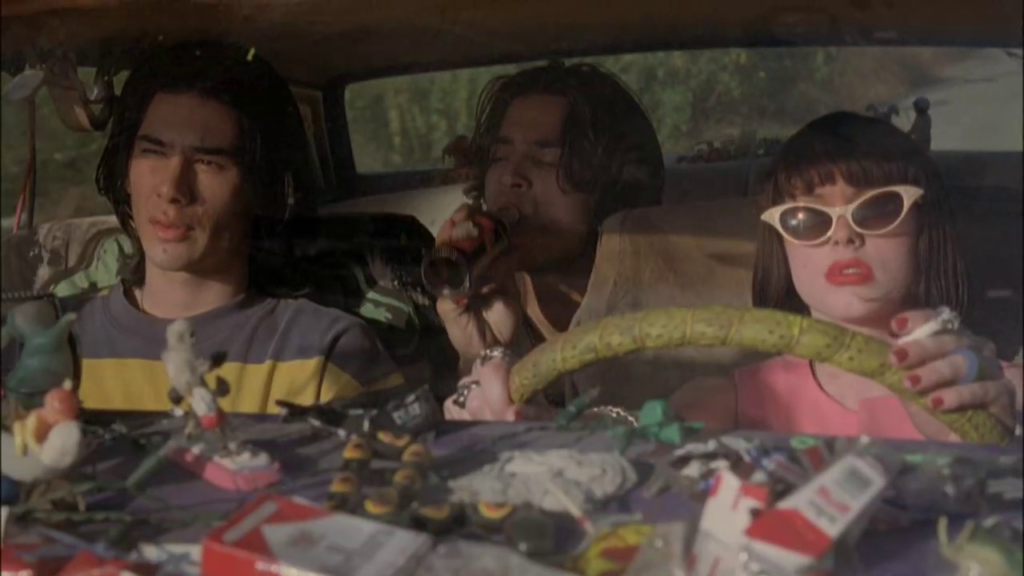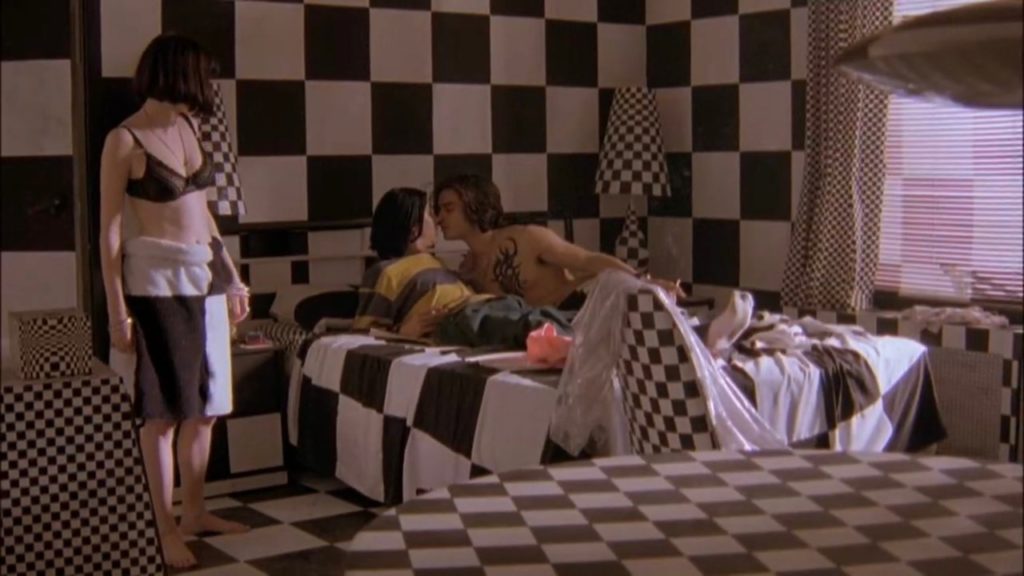Editorials
How Gregg Araki’s ‘The Doom Generation’ Steered My Queer Identity and Filmmaking
February 10th, 2021 | By Mark Pariselli

Upon its release in 1995, Gregg Araki’s The Doom Generation was lambasted by critics. It received a D grade from Entertainment Weekly, while Roger Ebert infamously gave the film a zero-star rating. Since then, it has become a cult classic, championed for its surreal production design, iconic costumes, and killer soundtrack. The Doom Generation influenced my burgeoning queer identity when I first saw it on VHS as a young teen and continues to inspire my filmmaking to this day.
The second installment in Araki’s Teenage Apocalypse Trilogy, The Doom Generation follows juvenile lovers Amy Blue (Rose McGowan) and Jordan White (James Duval) as they pick up a dangerous, handsome drifter named Xavier Red (Johnathon Schaech). After accidentally killing a QuickieMart owner, the trio embarks on a nightmarish road trip punctuated by profanity, junk food, kinky sex, and comic book violence that reaches a tragic and shocking climax.
Despite the subtitle, “A Heterosexual Movie By Gregg Araki,” The Doom Generation is inherently queer. Araki is recognized as a pioneer of New Queer Cinema, a term coined by B. Ruby Rich to describe a crop of films from the early 1990s—such as Araki’s The Living End—that seemed to share a common style and attitude. His not-gay-as-in-happy-but-queer-as-in-fuck-you sensibility fuels The Doom Generation.
“Teen is a Four Letter Word”
When the opening credits announce that a film is presented by “The Teen Angst Movie Company,” and “fuck” is uttered as the first word of dialogue, it is evident that subtlety is not the aim. And subtleness wasn’t what I wanted when I first saw The Doom Generation while coming to terms with my queerness. I was sick of the casual homophobia and GAP khakis prevalent in my suburban high school. Reading Dennis Cooper and listening to Portishead, I was alienated and sought an alternative representation of adolescence contrary to Clueless.
The first “fuck” is spoken by Amy. With her perfectly painted potty-mouth, dark bob haircut that was definitely not inspired by Uma Thurman’s look in Pulp Fiction, and “Eat, Fuck, Kill” button, she is one of my favorite film characters. Amy is everything I wanted to be: assertive—literally and figuratively—behind the wheel, adventurous and unapologetic about her sexual desires. She also fucks Xavier, my ultimate 90s crush. When bullied, I drew strength from her confidence and attitude. At the film’s grisly conclusion, she is no damsel in distress. Amy emerges as the blood-splattered final girl, freeing herself, saving Xavier, and fiercely fighting back against their attackers. I pay tribute to her in my short film, Monster Mash, where a queer male character dresses up as her for Halloween.
Referring to herself and Jordan, Amy observes, “There just is no place for us in this world.” This line is significant and resonated with me. Delivered with solemnity, it identifies Amy and Jordan as outsiders. Lacking out queer peers or role models, I felt the same way. Important enough to be included as the intro on the film’s CD soundtrack, the line also proves to be painfully prophetic.
Araki and Sexuality
Xavier crashes into their lives as his body smashes against the windshield of Amy’s car. He is fending off a Gang of Goons played by Skinny Puppy, who pointedly use “cocksucker” as their insult of choice. This obscenity is noteworthy. It situates Xavier, Amy, and Jordan within a culture that views sex acts between two men as abhorrent and reprehensible. It also foreshadows Xavier’s gruesome fate. Oozing blood and bad boy sex appeal, Xavier hijacks Amy and Jordan’s vehicle. He is the most overtly queer character in the film and derails their monogamous, heteronormative-seeming relationship. With his seductive swagger and anarchic outlook, Xavier catalyzes sexual experimentation. He propels Amy and Jordan beyond the limits of mainstream society.
The filmmaking language of The Doom Generation emboldens my work. Techniques of classical Hollywood cinema are subverted or reappropriated to serve the queer narrative. Araki positions Jordan and Xavier closer than two males are typically seen together on screen. It always looks like they are just about to kiss. The male figure is eroticized and admired, where traditionally, the female body is objectified in cinema. Though Amy’s breasts are bared throughout the film, the scale of nudity is balanced with Xavier displaying his muscular physique for most of the movie. Amy’s buttocks are glimpsed through her coveted transparent raincoat in the penultimate scene, whereas Jordan bends over and exposes his naked ass twice, and Xavier reveals his ass once.

In Amy’s absence, the camera slowly pushes in on the young men. Jordan and Xavier are framed in a two-shot usually reserved for the heterosexual leads of a rom-com love scene. Jordan interrupts this charged moment to urinate, but it seems to have aroused him enough to enable the consummation of his relationship with Amy. Subsequently, Jordan and Amy’s passionate bathtub sex inspires Xavier to masturbate. In a series of sensual close-ups, Xavier pinches his erect nipple. The camera lingers on the dark, coarse hair of his treasure-trail. When he closes his eyes and leans back to ejaculate, the image drifts dreamily out of focus, enhancing the swooning ecstasy of this release. The carnal sequence concludes with Xavier licking his semen off his hand.
Flickering Myth claims, “I could have happily gone through life without having seen James Duval’s arsecrack and ballbag and…certainly could have gone decades of happy years not watching Johnathon Schaech eating semen.” But this was just what I wanted to see. Araki’s favoring of the male form—and his subversive approach to depictions of sexuality onscreen—revealed my own desires. His queer gaze made me feel less alone and implied the existence of other viewers like me.
The sex scenes in The Doom Generation are galvanized by a dynamic editing rhythm, shifts in perspective, and various framing choices, but the camera is never predatory. The actors are not ogled like the cast of a Larry Clark film. Self-pleasure serves as a means of identity exploration, and sexual fluidity is celebrated. Araki’s approach to sexuality in The Doom Generation informed the masturbatory fantasy sequences in my short film, After.
Araki and Horror
Seven and Kids may have scared audiences in 1995, but The Doom Generation contains the year’s most horrifying and disturbing scene. It occurs at the climax of the film. On the lam, our Bonnie and two Clydes have confronted chaos at every rest stop, leaving a trail of maimed limbs and broken hearts. Played by sets of identical twins costumed in matching suits, the FBI is also on their case. The weary band of outsiders seeks refuge for the night in an abandoned warehouse.
Here, the garish, saturated lighting of the rest of the film is replaced by the warm glow of a campfire. Hyper-stylization is traded for subdued realism. Jordan, Amy, and Xavier have finally escaped the relentless threats of the outside world. The prospect of a pansexual, polyamorous utopia seems possible, if only within the protective ring of firelight. Unlike the animalistic coupling earlier in the film, the ensuing throupling is treated tenderly. Crossfades beautifully blur bodies and faces together. The soundscape is stripped bare except for an undulating mix of sighs and panting. Unfortunately, the call of nature interrupts again. Amy exits to urinate, leaving Xavier and Jordan together on a dirty mattress.

The screen boldly goes black for 46 seconds as a menacing, echoing male voice recites a homophobic rhyme. A flickering strobe light reveals that three men have invaded. They previously harassed Jordan, Xavier, and Amy in a record store and now appear naked, aside from tube socks over their genitals and swastikas painted across their chests. Amy is raped first by one of the men, then with a religious statue. Jordan is castrated with a pair of gardening shears, and his severed penis is shoved in Xavier’s mouth. The sexual outlaws are punished for their transgressions. Only Amy and Xavier survive.
Desensitized by the preceding farcical violence, the viewer is utterly unprepared for the extremity of this bloodbath. It is devastating and made overwhelming by Araki’s barrage of horror cinema techniques. The disorienting strobe lighting harkens back to the swinging naked bulb of the cellar reveal in Psycho. Paired with the layering of Jordan’s shattering, amplified screams, the scene also recalls Laura Palmer’s strobe-lit murder in David Lynch’s Twin Peaks: Fire Walk with Me released just three years earlier. The Doom Generation deserves more credit for its effective horror elements. The anger and urgency that drive this scene similarly motivate my short film, Family.
‘Family’ and Araki
Family mobilizes elements of the horror genre to critique heteronormative ideologies of family. Film theorist and critic Robin Wood observes that in horror cinema, “normality is threatened by the Monster.” Throughout film history, queer people and people of colour have been characterized as the abject or monstrous “others,” representing a threat to white, heterosexual normality. Family resists and reverses this convention as does The Doom Generation.
In Family, an interracial gay couple is presented as the norm, terrorized by a grotesque representation of traditional family values that threatens to absorb and erase through assimilation. The monster is the nuclear family, and its intrusion is rendered violently in the film. When the gay couple is physically attacked and the lead is struck in the head, the film itself suffers a blow, abruptly cutting to black. Using darkness and manipulating sound as in The Doom Generation, the viewer viscerally experiences horror and the damaging effects of normative social influence with the characters.
Araki’s rebellious spirit and unapologetically queer approach to filmmaking encourage me to defy expectations and challenge conformity in my own work. Genres can be blended; labels can be abandoned. My films similarly focus on outsiders searching for love in hostile environments while inspiration is drawn from Araki’s use of music and his provocative visual stylizing.
Conclusion
Entertainment Weekly wishes viewers “good luck searching for meaning” in The Doom Generation beyond “blood and epithets.” Yet, the brutal conclusion makes a powerful statement. Araki unsubtly condemns the oppressive, conservative ideology and homophobia of an America intent on annihilating unconventional sexuality.
The film has been criticized for its nihilism, and I agree that the ending is heartbreakingly bleak. Shellshocked, Amy and Xavier drive toward an uncertain future as Slowdive’s haunting “Blue Skied an’ Clear” rises on the soundtrack — one of cinema’s best music cues. But I accept Araki’s defense in Filmmaker Magazine that The Doom Generation is “also very much about love and its transcendent power.” For Araki, naïve and sensitive Jordan embodies the “purity and idealism” motivating all of the characters. “That’s why he’s the literal lamb of the slaughter at the end,” Araki explains, “because he personifies the kind of unselfish innocence that’s doomed in a cynical world.”
At a time when I was reluctant to rent a video with suggestively queer cover art for fear of being outed, The Doom Generation was my gateway to queer cinema. Veering far from the middle-of-the-road, it is the wild ride I wanted to take as a young teen. Like the best (road) trips, it was transformative, steering my queer identity and filmmaking.
Visit our Editorials page for more articles like this. Ready to support more original horror criticism? Join the Certified Forgotten Patreon community today.

